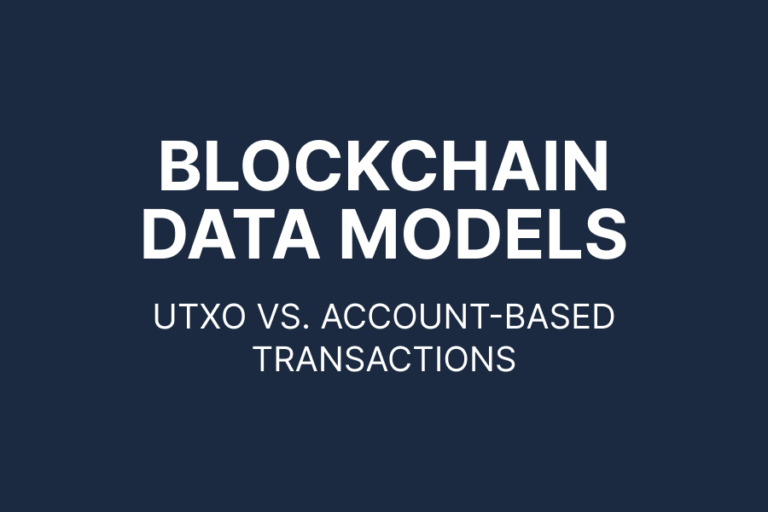There are two important ways to organize transactions, a bit like how different recipes help create different dishes and they are called blockchain data models.
Imagine the first way, called the UTXO model, like a game of hide-and-seek. Coins wear masks, representing money left over from previous transactions. When a new transaction happens, the UTXO model checks if these masked coins can be used. If they can, the masks come off, and new unspent coins are created for future transactions. This method keeps things clear and safe.
Now, think of the second way, the Account-Based model, like a bank account. Each person has their own unique address, just like a bank card number. Instead of tracking individual coins, this model keeps a record of how much money each person has, and when someone sends money, the record gets updated. This way is easier and more efficient.
The World of Blockchain Data Models
Before we dive into the specifics of UTXO and Account-Based models, let’s conjure up a basic understanding of what data models are all about. In the large scale of blockchain technology, data models serve as the magical abstractions of data characteristics. Think of them as the ancient scrolls that contain the blueprints for how transactions are structured and organized.
These data models are the architects of the blockchain kingdom, governing how transactions are created, validated, and stored. They are the guardians of efficiency and security, ensuring that every digital coin is accounted for, and every transaction is transparent.
Unspent Transaction Output (UTXO)
UTXO as a data model is a transaction model that follows a unique and rather mystical philosophy. In this world, transactions are recorded with an air of minimalism. UTXO, which stands for Unspent Transaction Output, only concerns itself with the transaction itself and cares not for the aftermath.
Imagine this as a grand masquerade ball where each coin, or rather, each “output”, wears a mask. These masked coins represent the unspent amounts from previous transactions. When a new transaction occurs, the UTXO model checks if these masked coins can be used to fulfill the transaction’s requirements. If they can, the masks are removed, and the coins are spent, creating new unspent outputs for future transactions.
The beauty of the UTXO model lies in its simplicity. It keeps a pristine record of transactions, ensuring that the lineage of each coin is clear and that double-spending, the arch-nemesis of all digital currencies, is thwarted.
Account-Based Transaction Model
As we venture deeper into the heart of the blockchain kingdom, we encounter the Account-Based transaction model, a system that embraces a more human-like approach. In this model, each user is bestowed with a unique address, akin to a bank card number in the traditional financial realm.
In essence, this model treats the blockchain as a grand ledger, much like a medieval book of accounts. Each user’s balance is recorded in this ledger, and transactions are merely entries in the account. When a user wishes to send digital currency, the ledger is updated to reflect the change in balance for both the sender and the recipient.
The Account-Based model offers its own brand of magic. It’s more efficient and convenient, much like the convenience of swiping a bank card to make a purchase. There’s no need to track individual coins or worry about their lineage. Instead, the focus is on account balances, making it easier to calculate and manage wealth within the kingdom.
Efficiency and Security
In this mystical world, there’s a constant tug-of-war between efficiency and security. The UTXO model, with its careful record-keeping, ensures that every coin’s history is crystal clear, providing robust security against fraudulent activities. However, this precision comes at the cost of complexity.
On the other hand, the Account-Based model streamlines the process, making transactions more efficient and user-friendly. Yet, this simplicity may come at the expense of some security measures.
In the end, the choice between the UTXO and Account-Based data models depends on the needs of the blockchain kingdom. Each model has its strengths and weaknesses, and the decision often comes down to the specific use case and priorities.
For those who prioritize security above all else, the UTXO model is like a protective spell that guards against malevolent forces. It ensures that no coin goes astray and that every transaction is accurately tracked.
For those who seek efficiency and ease of use, the Account-Based model is like a teleportation spell, making transactions swift and straightforward. It simplifies the process, allowing users to interact with the blockchain seamlessly.
So, the next time you send or receive digital currency in the blockchain kingdom, take a moment to appreciate the enchanting data models working behind the scenes, ensuring that your transactions are not only secure but also efficient – a true blend of magic and technology.



